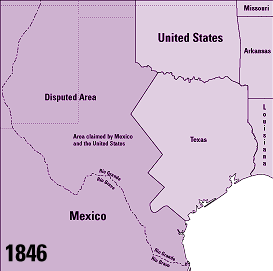|
|
|
War with Mexico
Introduction - Revival of Expansionism - The Oregon Question - War With Mexico
|
Relations between the United States and Mexico soured in December 1845, when Congress voted to admit Texas as the twenty-eighth state. A negotiated settlement to the Texas boundary question (now a disputed international boundary between the United States and Mexico) was complicated by frequent changes in Mexican leadership during 1845-46. After the Mexican government refused to meet with an American representative sent to negotiate the purchase of Mexican lands stretching northward from Texas to the Oregon Country in January 1846, Polk ordered U.S. troops into disputed territory on the north bank of the Río Grande. The inevitable conflict occurred on April 25, 1846, when a contingent of Mexican cavalry crossed the Río Grande and skirmished with the American forces.
|

Map showing region claimed by both the
United
States and Mexico until 1846.
|
During the nearly two years of war, American troops took possession of Mexican territory in what is now California, New Mexico, northern Mexico, and ultimately the capital, Mexico City. The Treaty of Guadalupe Hidalgo, which ended the war in February 1848, established dramatically altered boundaries for the United States and Mexico. Under the terms of Guadalupe Hidalgo, Mexico ceded to the United States an immense territory of nearly one million square miles, including land in what is now California, Nevada, Utah, New Mexico, Arizona, Colorado, Wyoming, Oklahoma, and Kansas. The United States, in turn, agreed to pay Mexico $15 million and assume $3.25 million in debt claims against Mexico. The treaty also provided that Mexican people who remained on their lands would be granted American citizenship and allowed to retain their property.
The Legacy of Expansion
By 1848, the Manifest Destiny championed by many Americans had been realized. The territory of the United States stretched from the Atlantic to the Pacific Coasts and from the 49th parallel to the Río Grande. Although they had been granted citizenship rights, many Mexican people who remained on their lands found the new American property laws complicated and confusing. Some unscrupulous American settlers used their greater familiarity with the law to acquire huge tracts of land owned by Mexicans.
The fertile territory acquired during 1840s also contained the bitter seeds of discord. Many Northerners and Southerners disagreed sharply over the slavery status of the territories, and eventually this dispute flamed into the carnage that was the Civil War. Today, the legacy of nineteenth century U.S. expansion is evident in the dynamic cultural and political interchange between the United States and Mexico. The people of each nation influence each other's language, food, music, and traditions, while their leaders continue to work together to resolve a host of political and environmental questions, including complex immigration, water rights, and land use issues.
|


